Scene Graph Generation
Scene graph generation is the process of creating structured representations of scenes that capture the relationships between objects.
Papers and Code
CausalNav: A Long-term Embodied Navigation System for Autonomous Mobile Robots in Dynamic Outdoor Scenarios
Jan 05, 2026Autonomous language-guided navigation in large-scale outdoor environments remains a key challenge in mobile robotics, due to difficulties in semantic reasoning, dynamic conditions, and long-term stability. We propose CausalNav, the first scene graph-based semantic navigation framework tailored for dynamic outdoor environments. We construct a multi-level semantic scene graph using LLMs, referred to as the Embodied Graph, that hierarchically integrates coarse-grained map data with fine-grained object entities. The constructed graph serves as a retrievable knowledge base for Retrieval-Augmented Generation (RAG), enabling semantic navigation and long-range planning under open-vocabulary queries. By fusing real-time perception with offline map data, the Embodied Graph supports robust navigation across varying spatial granularities in dynamic outdoor environments. Dynamic objects are explicitly handled in both the scene graph construction and hierarchical planning modules. The Embodied Graph is continuously updated within a temporal window to reflect environmental changes and support real-time semantic navigation. Extensive experiments in both simulation and real-world settings demonstrate superior robustness and efficiency.
GenCAMO: Scene-Graph Contextual Decoupling for Environment-aware and Mask-free Camouflage Image-Dense Annotation Generation
Jan 03, 2026Conceal dense prediction (CDP), especially RGB-D camouflage object detection and open-vocabulary camouflage object segmentation, plays a crucial role in advancing the understanding and reasoning of complex camouflage scenes. However, high-quality and large-scale camouflage datasets with dense annotation remain scarce due to expensive data collection and labeling costs. To address this challenge, we explore leveraging generative models to synthesize realistic camouflage image-dense data for training CDP models with fine-grained representations, prior knowledge, and auxiliary reasoning. Concretely, our contributions are threefold: (i) we introduce GenCAMO-DB, a large-scale camouflage dataset with multi-modal annotations, including depth maps, scene graphs, attribute descriptions, and text prompts; (ii) we present GenCAMO, an environment-aware and mask-free generative framework that produces high-fidelity camouflage image-dense annotations; (iii) extensive experiments across multiple modalities demonstrate that GenCAMO significantly improves dense prediction performance on complex camouflage scenes by providing high-quality synthetic data. The code and datasets will be released after paper acceptance.
Instance Communication System for Intelligent Connected Vehicles: Bridging the Gap from Semantic to Instance-Level Transmission
Dec 27, 2025Intelligent Connected Vehicles (ICVs) rely on high-speed data transmission for efficient and safety-critical services. However, the scarcity of wireless resources limits the capabilities of ICVs. Semantic Communication (SemCom) systems can alleviate this issue by extracting and transmitting task-relevant information, termed semantic information, instead of the entire raw data. Despite this, we reveal that residual redundancy persists within SemCom systems, where not all instances under the same semantic category are equally critical for downstream tasks. To tackle this issue, we introduce Instance Communication (InsCom), which elevates communication from the semantic level to the instance level for ICVs. Specifically, InsCom uses a scene graph generation model to identify all image instances and analyze their inter-relationships, thus distinguishing between semantically identical instances. Additionally, it applies user-configurable, task-critical criteria based on subject semantics and relation-object pairs to filter recognized instances. Consequently, by transmitting only task-critical instances, InsCom significantly reduces data redundancy, substantially enhancing transmission efficiency within limited wireless resources. Evaluations across various datasets and wireless channel conditions show that InsCom achieves a data volume reduction of over 7.82 times and a quality improvement ranging from 1.75 to 14.03 dB compared to the state-of-the-art SemCom systems.
SparScene: Efficient Traffic Scene Representation via Sparse Graph Learning for Large-Scale Trajectory Generation
Dec 24, 2025Multi-agent trajectory generation is a core problem for autonomous driving and intelligent transportation systems. However, efficiently modeling the dynamic interactions between numerous road users and infrastructures in complex scenes remains an open problem. Existing methods typically employ distance-based or fully connected dense graph structures to capture interaction information, which not only introduces a large number of redundant edges but also requires complex and heavily parameterized networks for encoding, thereby resulting in low training and inference efficiency, limiting scalability to large and complex traffic scenes. To overcome the limitations of existing methods, we propose SparScene, a sparse graph learning framework designed for efficient and scalable traffic scene representation. Instead of relying on distance thresholds, SparScene leverages the lane graph topology to construct structure-aware sparse connections between agents and lanes, enabling efficient yet informative scene graph representation. SparScene adopts a lightweight graph encoder that efficiently aggregates agent-map and agent-agent interactions, yielding compact scene representations with substantially improved efficiency and scalability. On the motion prediction benchmark of the Waymo Open Motion Dataset (WOMD), SparScene achieves competitive performance with remarkable efficiency. It generates trajectories for more than 200 agents in a scene within 5 ms and scales to more than 5,000 agents and 17,000 lanes with merely 54 ms of inference time with a GPU memory of 2.9 GB, highlighting its superior scalability for large-scale traffic scenes.
Object-Centric Framework for Video Moment Retrieval
Dec 20, 2025Most existing video moment retrieval methods rely on temporal sequences of frame- or clip-level features that primarily encode global visual and semantic information. However, such representations often fail to capture fine-grained object semantics and appearance, which are crucial for localizing moments described by object-oriented queries involving specific entities and their interactions. In particular, temporal dynamics at the object level have been largely overlooked, limiting the effectiveness of existing approaches in scenarios requiring detailed object-level reasoning. To address this limitation, we propose a novel object-centric framework for moment retrieval. Our method first extracts query-relevant objects using a scene graph parser and then generates scene graphs from video frames to represent these objects and their relationships. Based on the scene graphs, we construct object-level feature sequences that encode rich visual and semantic information. These sequences are processed by a relational tracklet transformer, which models spatio-temporal correlations among objects over time. By explicitly capturing object-level state changes, our framework enables more accurate localization of moments aligned with object-oriented queries. We evaluated our method on three benchmarks: Charades-STA, QVHighlights, and TACoS. Experimental results demonstrate that our method outperforms existing state-of-the-art methods across all benchmarks.
LangDriveCTRL: Natural Language Controllable Driving Scene Editing with Multi-modal Agents
Dec 19, 2025
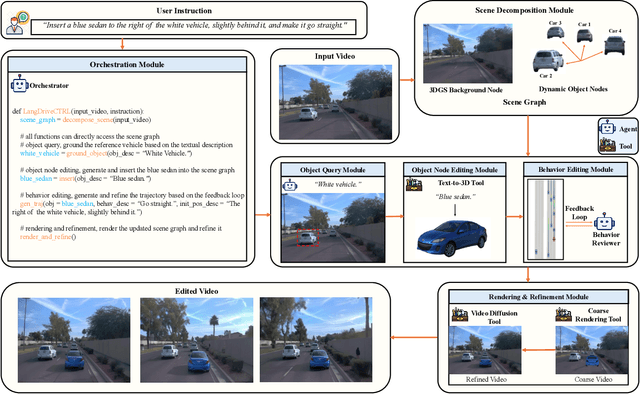

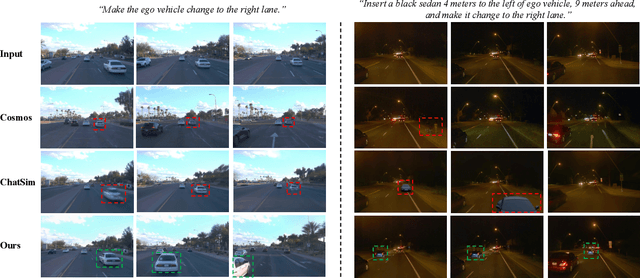
LangDriveCTRL is a natural-language-controllable framework for editing real-world driving videos to synthesize diverse traffic scenarios. It leverages explicit 3D scene decomposition to represent driving videos as a scene graph, containing static background and dynamic objects. To enable fine-grained editing and realism, it incorporates an agentic pipeline in which an Orchestrator transforms user instructions into execution graphs that coordinate specialized agents and tools. Specifically, an Object Grounding Agent establishes correspondence between free-form text descriptions and target object nodes in the scene graph; a Behavior Editing Agent generates multi-object trajectories from language instructions; and a Behavior Reviewer Agent iteratively reviews and refines the generated trajectories. The edited scene graph is rendered and then refined using a video diffusion tool to address artifacts introduced by object insertion and significant view changes. LangDriveCTRL supports both object node editing (removal, insertion and replacement) and multi-object behavior editing from a single natural-language instruction. Quantitatively, it achieves nearly $2\times$ higher instruction alignment than the previous SoTA, with superior structural preservation, photorealism, and traffic realism. Project page is available at: https://yunhe24.github.io/langdrivectrl/.
Bridging Modalities and Transferring Knowledge: Enhanced Multimodal Understanding and Recognition
Dec 23, 2025This manuscript explores multimodal alignment, translation, fusion, and transference to enhance machine understanding of complex inputs. We organize the work into five chapters, each addressing unique challenges in multimodal machine learning. Chapter 3 introduces Spatial-Reasoning Bert for translating text-based spatial relations into 2D arrangements between clip-arts. This enables effective decoding of spatial language into visual representations, paving the way for automated scene generation aligned with human spatial understanding. Chapter 4 presents a method for translating medical texts into specific 3D locations within an anatomical atlas. We introduce a loss function leveraging spatial co-occurrences of medical terms to create interpretable mappings, significantly enhancing medical text navigability. Chapter 5 tackles translating structured text into canonical facts within knowledge graphs. We develop a benchmark for linking natural language to entities and predicates, addressing ambiguities in text extraction to provide clearer, actionable insights. Chapter 6 explores multimodal fusion methods for compositional action recognition. We propose a method fusing video frames and object detection representations, improving recognition robustness and accuracy. Chapter 7 investigates multimodal knowledge transference for egocentric action recognition. We demonstrate how multimodal knowledge distillation enables RGB-only models to mimic multimodal fusion-based capabilities, reducing computational requirements while maintaining performance. These contributions advance methodologies for spatial language understanding, medical text interpretation, knowledge graph enrichment, and action recognition, enhancing computational systems' ability to process complex, multimodal inputs across diverse applications.
SNOW: Spatio-Temporal Scene Understanding with World Knowledge for Open-World Embodied Reasoning
Dec 18, 2025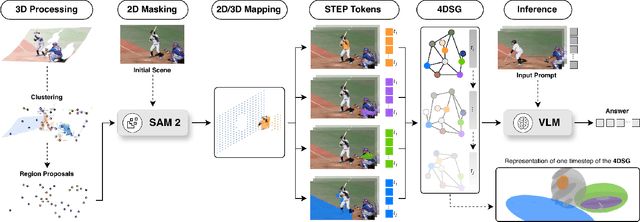
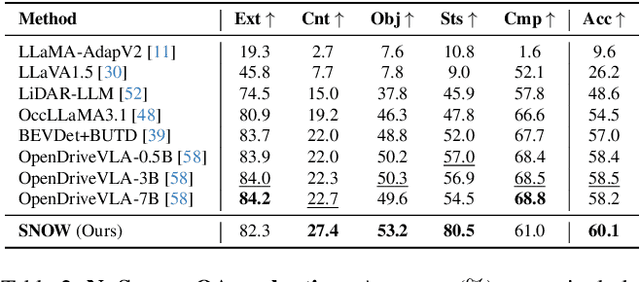

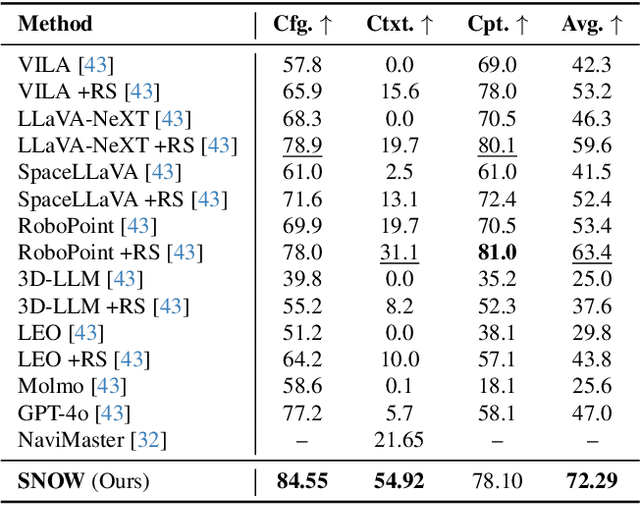
Autonomous robotic systems require spatio-temporal understanding of dynamic environments to ensure reliable navigation and interaction. While Vision-Language Models (VLMs) provide open-world semantic priors, they lack grounding in 3D geometry and temporal dynamics. Conversely, geometric perception captures structure and motion but remains semantically sparse. We propose SNOW (Scene Understanding with Open-World Knowledge), a training-free and backbone-agnostic framework for unified 4D scene understanding that integrates VLM-derived semantics with point cloud geometry and temporal consistency. SNOW processes synchronized RGB images and 3D point clouds, using HDBSCAN clustering to generate object-level proposals that guide SAM2-based segmentation. Each segmented region is encoded through our proposed Spatio-Temporal Tokenized Patch Encoding (STEP), producing multimodal tokens that capture localized semantic, geometric, and temporal attributes. These tokens are incrementally integrated into a 4D Scene Graph (4DSG), which serves as 4D prior for downstream reasoning. A lightweight SLAM backend anchors all STEP tokens spatially in the environment, providing the global reference alignment, and ensuring unambiguous spatial grounding across time. The resulting 4DSG forms a queryable, unified world model through which VLMs can directly interpret spatial scene structure and temporal dynamics. Experiments on a diverse set of benchmarks demonstrate that SNOW enables precise 4D scene understanding and spatially grounded inference, thereby setting new state-of-the-art performance in several settings, highlighting the importance of structured 4D priors for embodied reasoning and autonomous robotics.
Seeing is Believing (and Predicting): Context-Aware Multi-Human Behavior Prediction with Vision Language Models
Dec 17, 2025Accurately predicting human behaviors is crucial for mobile robots operating in human-populated environments. While prior research primarily focuses on predicting actions in single-human scenarios from an egocentric view, several robotic applications require understanding multiple human behaviors from a third-person perspective. To this end, we present CAMP-VLM (Context-Aware Multi-human behavior Prediction): a Vision Language Model (VLM)-based framework that incorporates contextual features from visual input and spatial awareness from scene graphs to enhance prediction of humans-scene interactions. Due to the lack of suitable datasets for multi-human behavior prediction from an observer view, we perform fine-tuning of CAMP-VLM with synthetic human behavior data generated by a photorealistic simulator, and evaluate the resulting models on both synthetic and real-world sequences to assess their generalization capabilities. Leveraging Supervised Fine-Tuning (SFT) and Direct Preference Optimization (DPO), CAMP-VLM outperforms the best-performing baseline by up to 66.9% in prediction accuracy.
LINA: Learning INterventions Adaptively for Physical Alignment and Generalization in Diffusion Models
Dec 15, 2025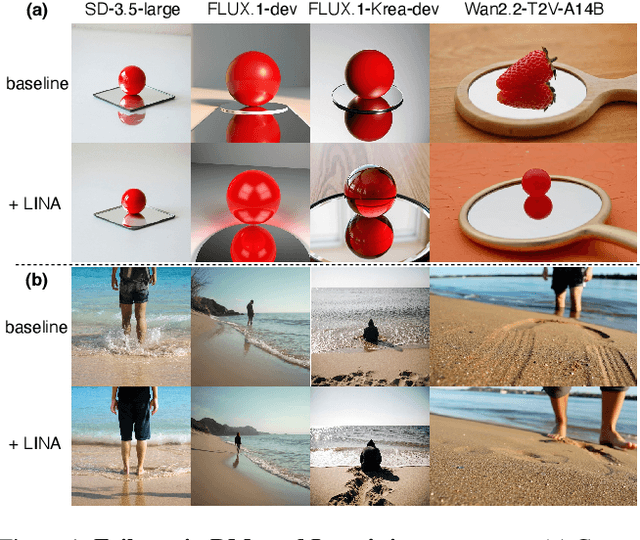
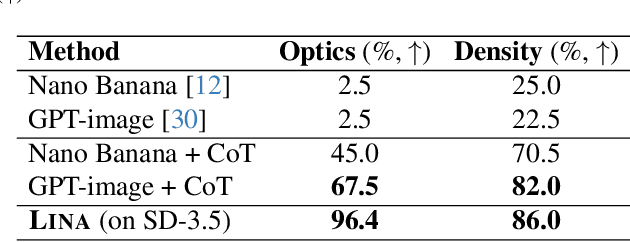
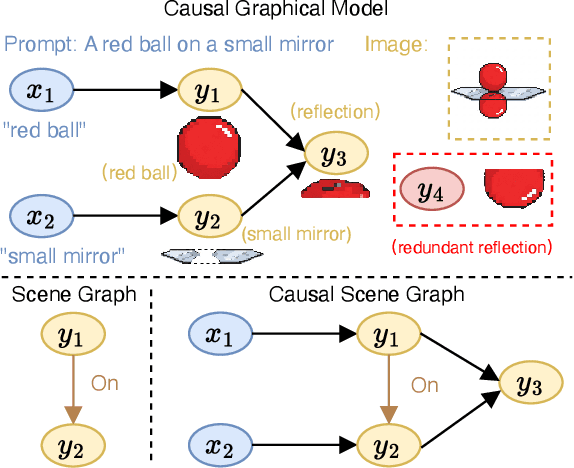
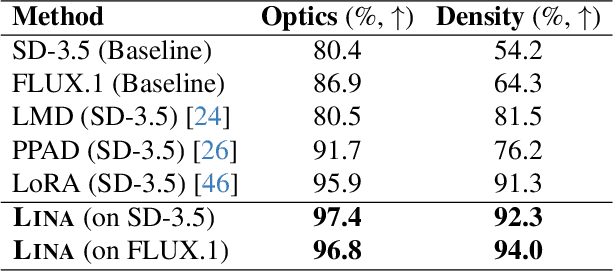
Diffusion models (DMs) have achieved remarkable success in image and video generation. However, they still struggle with (1) physical alignment and (2) out-of-distribution (OOD) instruction following. We argue that these issues stem from the models' failure to learn causal directions and to disentangle causal factors for novel recombination. We introduce the Causal Scene Graph (CSG) and the Physical Alignment Probe (PAP) dataset to enable diagnostic interventions. This analysis yields three key insights. First, DMs struggle with multi-hop reasoning for elements not explicitly determined in the prompt. Second, the prompt embedding contains disentangled representations for texture and physics. Third, visual causal structure is disproportionately established during the initial, computationally limited denoising steps. Based on these findings, we introduce LINA (Learning INterventions Adaptively), a novel framework that learns to predict prompt-specific interventions, which employs (1) targeted guidance in the prompt and visual latent spaces, and (2) a reallocated, causality-aware denoising schedule. Our approach enforces both physical alignment and OOD instruction following in image and video DMs, achieving state-of-the-art performance on challenging causal generation tasks and the Winoground dataset. Our project page is at https://opencausalab.github.io/LINA.
 Add to Chrome
Add to Chrome Add to Firefox
Add to Firefox Add to Edge
Add to Edge